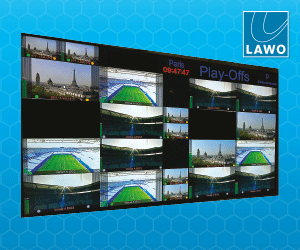As consumers increasingly view content on multiple screens, easy navigation becomes more important and it’s critical to provide them with ways to find what they want, says Adam Nightingale The world of TV has changed dramatically in recent years. Consumers are finding and viewing content on more devices than ever before. The influx of devices, […]

VP Sales EMEA at Accedo.
As consumers increasingly view content on multiple screens, easy navigation becomes more important and it’s critical to provide them with ways to find what they want, says Adam Nightingale
The world of TV has changed dramatically in recent years. Consumers are finding and viewing content on more devices than ever before.
The influx of devices, coupled with consumer demand for all content to be available across all devices, has led to a fragmented, complex and chaotic marketplace. Finding services that deliver great content, and finding the content offered by those services, can be like finding a needle in a haystack.
Although the marketplace is chaotic, multiscreen premium content services can help broadcasters and TV content providers differentiate their offerings with a range of compelling value-added services. The best technology systems also give them an efficient way of managing and reducing that complexity.
Delivering interactivity, engaging with consumers
The killer app for television is still watching television, but as TV has become much more interactive, the way in which consumers find their way to that content is changing. Linear consumption is decreasing and content is now being viewed on a wider ecosystem of consumer devices. As well as making it easier for consumers to watch content whenever and wherever they want, broadcasters and TV platform operators are now able to tap into a wider universe of consumers. This is allowing them to generate new revenues, create a more engaging interactive experience to change the relationship consumers have with their service providers.
The next evolutionary step will be interactivity between platforms. Consumers will become frustrated with each device interacting with entertainment platforms on a 1:1 basis and will expect better cross-device connectivity. We are already seeing a growing demand for companion apps, allowing consumers to use smartphones and tablet devices to enjoy a richer way of navigating through content available on smart TVs. As well as providing remote control functions, advanced search and richer EPG data, companion apps can include social connectivity and in-programme functions such as voting, tweeting and so on.
The challenge that we all have is to get better at building ecosystems of managed, connected devices and making the user experience logical and intuitive. As a consumer, if I have an entitlement to access content on my iPhone then I want those same entitlements to be mirrored on my smart TV, PC, Android tablet or even perhaps, via Google Glass. So the challenge spans not just elegant user experiences and technology, but also includes the need to ensure that acquisition teams negotiate content licensing and distribution rights that enable platform operators and broadcasters to deliver a truly engaging multiscreen service.
If you build it, will they come?
If content is king then surely so is discoverability, both of that wonderful content, but also of the service itself. Success is, therefore, a function not just of an engaging user experience but also of ensuring that potential users can find the service in the first place.
The marketing effort required to make consumers aware of apps and services is immense. There are more service providers, more devices and increasingly complicated content rights. Launching a fantastic OTT multiscreen service is not easy, making it succeed is even harder. Its not just a case of if you build it they will come they have to find it first.
Also, the devices themselves can often be cumbersome to navigate and its difficult to find new services in the vast expanse of the app world. Incumbent providers have a headstart, and companies like Netflix, which have invested heavily in technology, marketing, content creation and distribution deals, already have a strong position from which they can promote themselves.
Device manufactures are trying to bring cross-platform content discovery to the market, but theyre missing the first step, which is for consumers to discover the services themselves.
Consumers should be in control of the home screen and should be presented with attractive application suggestions in an integrated way. The manufacturers control the platform and with active editorial functionality and recommendations should be able to provide recommendations to consumers in a more attractive way than just lists of apps. Broadcasters and TV platform providers should take a less protectionist view, and establish themselves as the de facto provider of premium content, allowing consumers to use their app as the gateway to find content across a wider spectrum of service providers.
A role to play
There is no doubt the broadcast industry is changing at a rapid pace. Broadcasters need to embrace this new environment to keep up with consumer demand, but they are also in a unique position to offer a much more integrated experience by deploying apps associated with programming, and supplementing their channels with OTT services.
The market in MENA is still quite young and most consumers in the region have not yet had the luxury of experiencing any content, any time, anywhere. Once they do, things will then take off even faster, and we will see competition from OTT providers forcing the traditional payTV platforms to follow their lead and sharpen their services.
Multiscreen TV apps, whether for interactive add-on services, OTT or other offerings, are more than ever crucial to keeping up with the fast rate of change. They offer consumers compelling, intuitive and interactive experiences on a multitude of devices. With careful planning, the right attitude and a fantastic multiscreen user experience, the needle may be far easier to find in that big messy haystack.
















































































